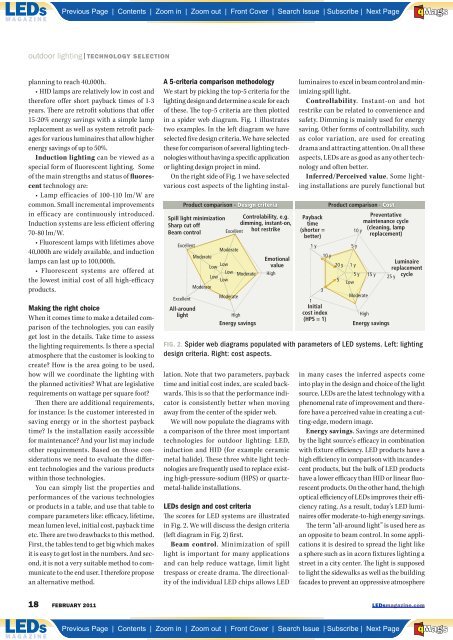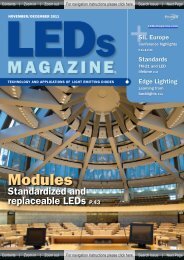The best solutions for any LED measurement application! - Beriled
The best solutions for any LED measurement application! - Beriled
The best solutions for any LED measurement application! - Beriled
Create successful ePaper yourself
Turn your PDF publications into a flip-book with our unique Google optimized e-Paper software.
A<br />
Previous Page | Contents | Zoom in | Zoom out | Front Cover | Search Issue | Subscribe | Next Page M S BE<br />
aG<br />
F<br />
outdoor lighting | TECHNOLOGY SELECTION<br />
planning to reach 40,000h.<br />
• HID lamps are relatively low in cost and<br />
there<strong>for</strong>e offer short payback times of 1-3<br />
years. Th ere are retrofi t <strong>solutions</strong> that off er<br />
15-20% energy savings with a simple lamp<br />
replacement as well as system retrofi t packages<br />
<strong>for</strong> various luminaires that allow higher<br />
energy savings of up to 50%.<br />
Induction lighting can be viewed as a<br />
special <strong>for</strong>m of fl uorescent lighting. Some<br />
of the main strengths and status of fl uorescent<br />
technology are:<br />
• Lamp efficacies of 100-110 lm/W are<br />
common. Small incremental improvements<br />
in efficacy are continuously introduced.<br />
Induction systems are less effi cient off ering<br />
70-80 lm/W.<br />
• Fluorescent lamps with lifetimes above<br />
40,000h are widely available, and induction<br />
lamps can last up to 100,000h.<br />
• Fluorescent systems are offered at<br />
the lowest initial cost of all high-effi cacy<br />
products.<br />
Making the right choice<br />
When it comes time to make a detailed comparison<br />
of the technologies, you can easily<br />
get lost in the details. Take time to assess<br />
the lighting requirements. Is there a special<br />
atmosphere that the customer is looking to<br />
create? How is the area going to be used,<br />
how will we coordinate the lighting with<br />
the planned activities? What are legislative<br />
requirements on wattage per square foot?<br />
Th en there are additional requirements,<br />
<strong>for</strong> instance: Is the customer interested in<br />
saving energy or in the shortest payback<br />
time? Is the installation easily accessible<br />
<strong>for</strong> maintenance? And your list may include<br />
other requirements. Based on those considerations<br />
we need to evaluate the diff erent<br />
technologies and the various products<br />
within those technologies.<br />
You can simply list the properties and<br />
per<strong>for</strong>mances of the various technologies<br />
or products in a table, and use that table to<br />
compare parameters like: effi cacy, lifetime,<br />
mean lumen level, initial cost, payback time<br />
etc. Th ere are two drawbacks to this method.<br />
First, the tables tend to get big which makes<br />
it is easy to get lost in the numbers. And second,<br />
it is not a very suitable method to communicate<br />
to the end user. I there<strong>for</strong>e propose<br />
an alternative method.<br />
A 5-criteria comparison methodology<br />
We start by picking the top-5 criteria <strong>for</strong> the<br />
lighting design and determine a scale <strong>for</strong> each<br />
of these. Th e top-5 criteria are then plotted<br />
in a spider web diagram. Fig. 1 illustrates<br />
two examples. In the left diagram we have<br />
selected fi ve design criteria. We have selected<br />
these <strong>for</strong> comparison of several lighting technologies<br />
without having a specifi c <strong>application</strong><br />
or lighting design project in mind.<br />
On the right side of Fig. 1 we have selected<br />
various cost aspects of the lighting instal-<br />
Product comparison - Design criteria<br />
Spill light minimization Controlability, e.g.<br />
Sharp cut off<br />
dimming, instant-on,<br />
Beam control<br />
Excellent hot restrike<br />
Moderate<br />
Moderate<br />
Low<br />
Moderate<br />
Moderate<br />
Low<br />
Excellent<br />
Low<br />
Low<br />
Low<br />
Excellent<br />
All-around<br />
light<br />
Moderate<br />
High<br />
Energy savings<br />
Emotional<br />
value<br />
High<br />
lation. Note that two parameters, payback<br />
time and initial cost index, are scaled backwards.<br />
Th is is so that the per<strong>for</strong>mance indicator<br />
is consistently better when moving<br />
away from the center of the spider web.<br />
We will now populate the diagrams with<br />
a comparison of the three most important<br />
technologies <strong>for</strong> outdoor lighting: <strong>LED</strong>,<br />
induction and HID (<strong>for</strong> example ceramic<br />
metal halide). Th ese three white light technologies<br />
are frequently used to replace existing<br />
high-pressure-sodium (HPS) or quartzmetal-halide<br />
installations.<br />
<strong>LED</strong>s design and cost criteria<br />
Th e scores <strong>for</strong> <strong>LED</strong> systems are illustrated<br />
in Fig. 2. We will discuss the design criteria<br />
(left diagram in Fig. 2) fi rst.<br />
Beam control. Minimization of spill<br />
light is important <strong>for</strong> m<strong>any</strong> <strong>application</strong>s<br />
and can help reduce wattage, limit light<br />
trespass or create drama. Th e directionality<br />
of the individual <strong>LED</strong> chips allows <strong>LED</strong><br />
luminaires to excel in beam control and minimizing<br />
spill light.<br />
Controllability. Instant-on and hot<br />
restrike can be related to convenience and<br />
safety. Dimming is mainly used <strong>for</strong> energy<br />
saving. Other <strong>for</strong>ms of controllability, such<br />
as color variation, are used <strong>for</strong> creating<br />
drama and attracting attention. On all these<br />
aspects, <strong>LED</strong>s are as good as <strong>any</strong> other technology<br />
and often better.<br />
Inferred/Perceived value. Some lighting<br />
installations are purely functional but<br />
Payback<br />
time<br />
(shorter =<br />
better)<br />
1 y<br />
3<br />
10 y<br />
1<br />
Initial<br />
cost index<br />
(HPS = 1)<br />
Product comparison - Cost<br />
20 y<br />
5<br />
Low<br />
Preventative<br />
maintenance cycle<br />
(cleaning, lamp<br />
10 y<br />
replacement)<br />
5 y<br />
1 y<br />
5 y<br />
Moderate<br />
High<br />
15 y<br />
Energy savings<br />
Luminaire<br />
replacement<br />
25 y cycle<br />
FIG. 2. Spider web diagrams populated with parameters of <strong>LED</strong> systems. Left: lighting<br />
design criteria. Right: cost aspects.<br />
in m<strong>any</strong> cases the inferred aspects come<br />
into play in the design and choice of the light<br />
source. <strong>LED</strong>s are the latest technology with a<br />
phenomenal rate of improvement and there<strong>for</strong>e<br />
have a perceived value in creating a cutting-edge,<br />
modern image.<br />
Energy savings. Savings are determined<br />
by the light source’s effi cacy in combination<br />
with fi xture effi ciency. <strong>LED</strong> products have a<br />
high effi ciency in comparison with incandescent<br />
products, but the bulk of <strong>LED</strong> products<br />
have a lower effi cacy than HID or linear fl uorescent<br />
products. On the other hand, the high<br />
optical effi ciency of <strong>LED</strong>s improves their effi -<br />
ciency rating. As a result, today’s <strong>LED</strong> luminaires<br />
off er moderate-to-high energy savings.<br />
Th e term “all-around light” is used here as<br />
an opposite to beam control. In some <strong>application</strong>s<br />
it is desired to spread the light like<br />
a sphere such as in acorn fi xtures lighting a<br />
street in a city center. Th e light is supposed<br />
to light the sidewalks as well as the building<br />
facades to prevent an oppressive atmosphere<br />
18 FEBRUARY 2011 <strong>LED</strong>smagazine.com<br />
A<br />
Previous Page | Contents | Zoom in | Zoom out | Front Cover | Search Issue | Subscribe | Next Page M S BE<br />
aG<br />
F

















